
Do you find it frustrating to print, sign, and scan documents whenever you need to complete a transaction? Electronic signature are the solution you need!
This technology allows you to digitally and securely sign documents, saving time and money, and is suitable for the environment.
For more information, let’s look at what electronic signatures are and how to create electronic signatures in this article!
What is an Electronic Signature?
According to Indonesian Law No. 11 of 2008,
an electronic signature consists of electronic information attached, associated, or related to other Electronic Information used as a verification and authentication tool.
On the other hand, The U.S. Federal ESIGN Act defines an electronic signature as
an electronic sound, symbol, or process, attached to or logically associated with a contract or other record and executed or adopted by a person with the intent to sign the record.
In other words, an electronic signature is any signature that takes an electronic form, whether you do it yourself or use an electronic signature platform or the best signature application, such as Mekari Sign.
Global Electronic Signature Legal Framework
Countries and regions have varying laws and regulations regarding electronic signatures, but many have recognized their validity and enforceability.
For example, the US has laws like ESIGN and UETA that regulate electronic signatures for business purposes. The EU has the eIDAS Regulation, which makes electronic signatures legally binding in member states if they meet specific requirements for authenticity and validity.
Other countries, including Canada, Australia, and Brazil, have laws that recognize the validity of electronic signatures; however, the rules can vary from nation to nation. When using electronic signatures, knowing each place’s specific requirements is essential.
Electronic Signature Legal Framework in Indonesia
The legal basis for electronic signatures is primarily found in the Indonesian Information and Electronic Transactions Act No. 11/2008 (UU ITE). Furthermore, the regulations regarding electronic signatures are explained in Article 52, Paragraph 2 of Regulation No. 82/2012, while Article 54, Paragraph 1 divides electronic signatures into two types:
- Certified Electronic Signature (TTE Tersertifikasi): A certified electronic signature uses electronic certification services and is proven by an Electronic Certificate.
- Non-Certified Electronic Signature (TTE Tidak Tersertifikasi): A non-certified electronic signature can be created without electronic certification services.
Certified Electronic Signature has legal validity if they meet the following requirements:
- The data used to create the electronic signature is only related to the signatory.
- The data used to create the electronic signature is under the control of the signatory during the electronic signing process.
- Any changes made to the electronic signature after signing can be detected.
- Any changes made to the electronic information related to the electronic signature after signing can be detected.
- There is a specific method used to identify the signatory.
- A specific method is used to indicate that the signatory has approved the related electronic information.
Also Read: What is Certified Authority in Digital Signature?
Why Use Electronic Signature?
In general, electronic signatures have so many functions that are useful for the user, including:
- Proving the authenticity and validity of digital documents.
- Strengthening the security of documents as they are difficult to forge.
- Accelerating the signing process.
- Simplifying the signing process with multiple parties remotely.
- You can sign in from anywhere, anytime, and on any device that supports it.
- Shortening decision-making processes.
- Increasing productivity as all processes are faster and more efficient.
- Reducing expenses because electronic signatures are digital, so you do not need to buy ink, paper, print, and so on.
- Reducing the risk of document damage, especially when sending them using courier services.
Benefits of Electronic Signature
Compared to traditional signatures, electronic signatures offer several benefits. Here are some advantages you can experience:
1. Cost saving
The first benefit of electronic signatures is cost-saving. With electronic signatures, you don’t have to print, scan, or send documents via courier. All you need is an internet connection and a supported device.
2. Time-saving
Instead of waiting several days for couriers to deliver documents, all parties can sign electronically in minutes. Especially when the parties are in different cities or countries, this saves a lot of time.
3. Improved security
Cases of document forgery and signature fraud are pretty common. Physical documents are easy to forge, especially using third-party services such as couriers.
This is not the case with electronic signatures because the document is sent personally to the relevant parties, ensuring greater confidentiality and security.
This is particularly true when using electronic signature applications cooperating with Public Service Registry (PSrE) like Mekari Sign.
4. Increased productivity
As mentioned earlier, electronic signatures can save costs and time, which can contribute positively to your productivity. You don’t have to wait long for necessary approvals or decisions and can complete them within minutes.
5. Environmentally friendly
Finally, electronic signatures are environmentally friendly technology because all processes are carried out virtually or online.
How to Register for an Electronic Signature
Before using a certified electronic signature in Mekari Sign, you must complete eKYC (Electronic Know Your Customer) first. Don’t worry, eKYC is safe and sophisticated, so it takes little time.
1. Verify your Identity with your ID Card
First, verify your identity with your ID card to check Dukcapil.
2. Biometric verification
There will be biometric verification to prevent identity theft. This will minimize identity fraud and signature forgery.
3. Create your PIN
Finally, create your PIN for extra security in Mekari Sign. Once completed, confirm your PIN.
How to Create an Electronic Signature
You can easily create an electronic signature through Mekari Sign. Here’s a complete guide:
Step 1. Visit the Mekari Sign website
First, you need to visit the Mekari Sign website located at mekarisign.com. If you already have a Mekari account, you can click Login in the upper right corner of the page. If not, click Schedule a Demo to meet with the Mekari Sign team and create an account.
Step 2. Complete eKYC
Before uploading a document, you must complete eKYC, as we explained above. Make sure you follow all the steps that appear on the website.
Step 3. Upload documents
The Mekari Sign dashboard will appear after logging in or creating a new account. By using the Upload Document feature, you can upload the document you want to sign and create an electronic signature.
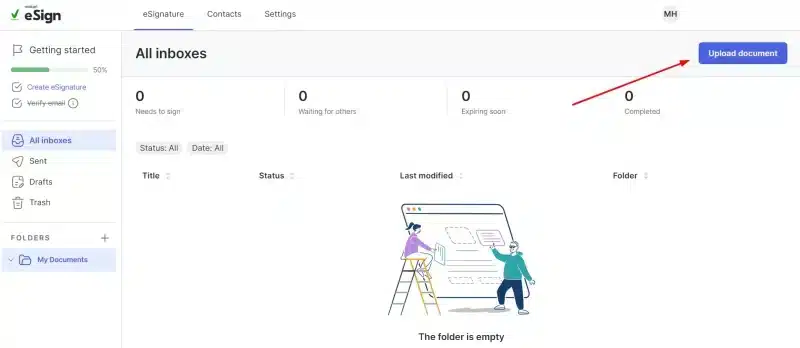
Select the electronic signature document stored on your device by clicking Upload your document. Alternatively, you can simply drag and drop your document into the open box.
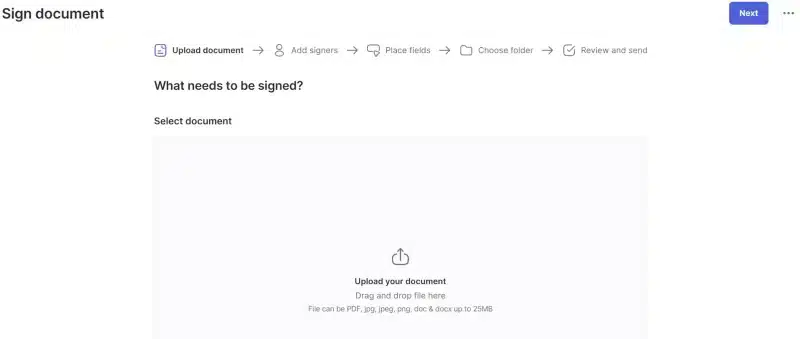
Make sure your document is in DOC, DOCX, PDF, JPG, JPEG, PNG, or other formats. Additionally, the size shouldn’t surpass 25 MB. We made use of a 29 KB online PDF signature document for this example.
To continue, click Next in the upper right corner after selecting your document.

Step 4. Set Who Will Sign the Document
Next, you are required to enter the parties who will sign the document. You enter their names and email addresses in the available column. Then, make sure the last column is set to Needs to sign.
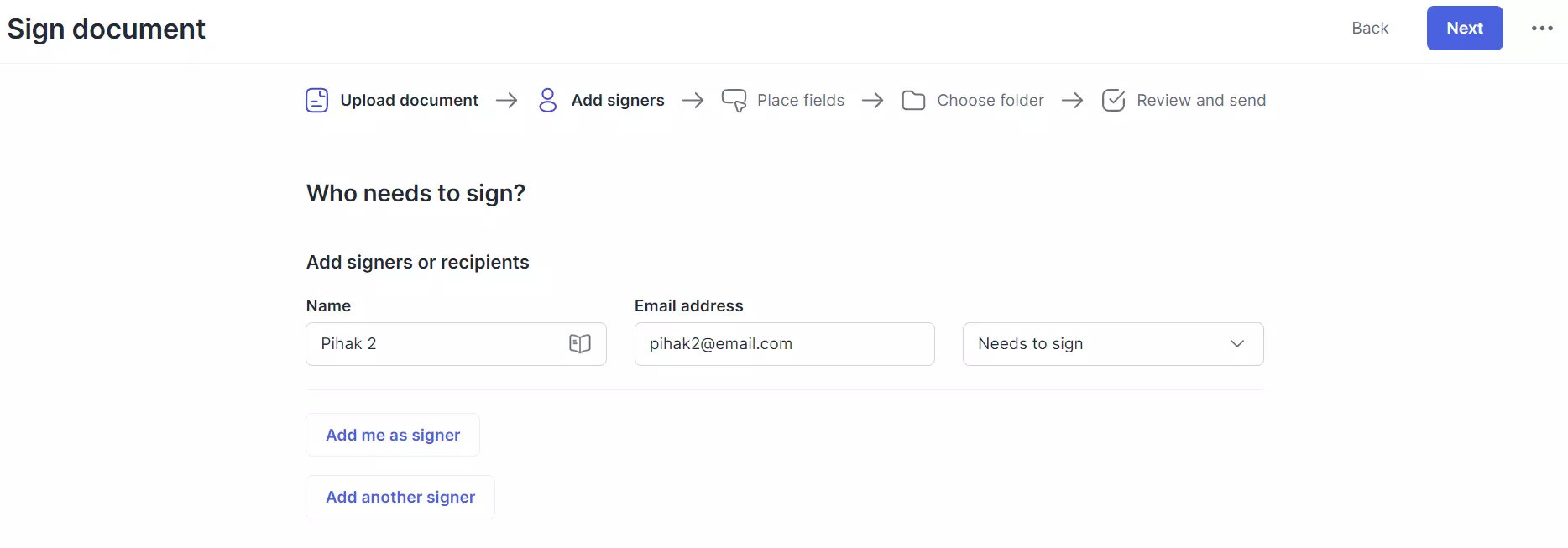
You can click Add me as a signer to include yourself as one of the parties. Or, if you want to have someone else, click Add another signer.
Step 5. Set the Signing Order
Sometimes, some documents require the parties to sign in a specific order. No need to worry, you can easily set the order in Mekari Sign. Click Set sign order, then dots will appear next to the names like this:
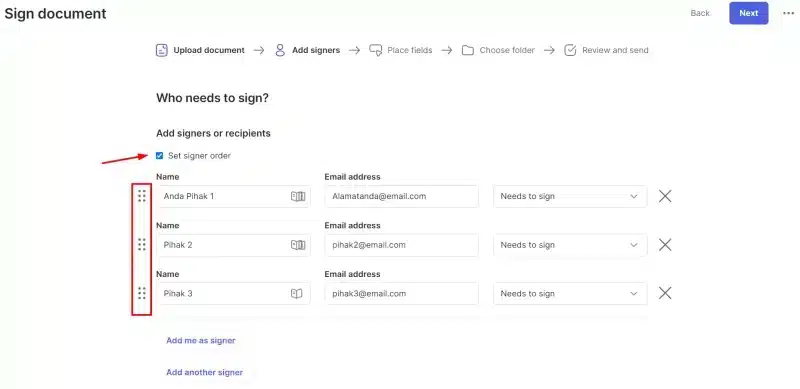
You can click and drag these dots to set the order of the parties who will sign. Once completed, click Next to continue.
Step 6. Set the Signature
At this stage, you can set the signature for each party. Starting from the signature position, name, contract duration, and date to the email address. Click and drag the options on the left to preview the document. For example:
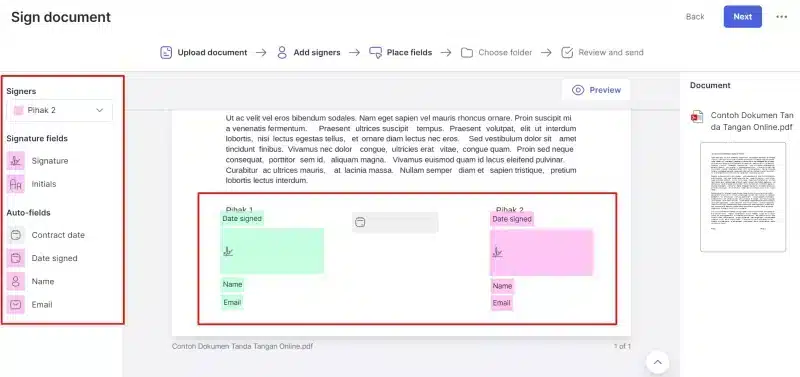
Once all parties have been set, click Next to continue.
Step 7. Select the Storage Folder
Here, you are required to select the folder that will be used to store the signed documents. This is not a folder on your device but on the Mekari Sign dashboard.

By default, the storage folder is My Documents. But you can change it by clicking Change, then Create New Folder.
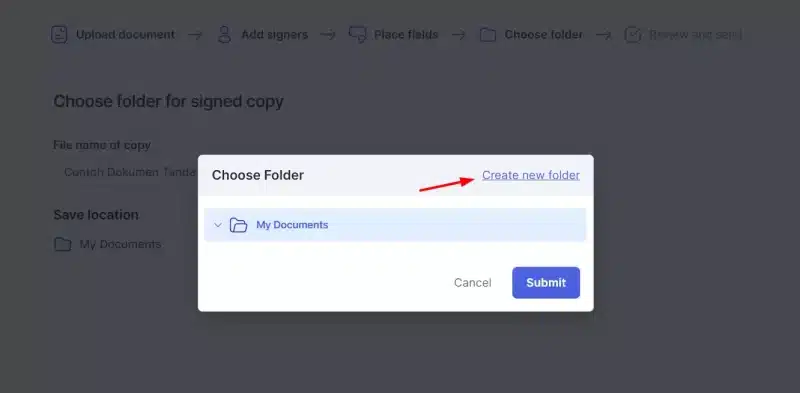
Enter the name as per your needs, then click Submit.
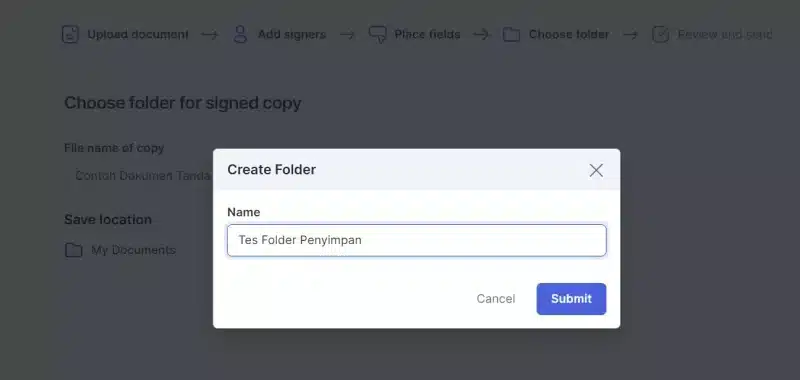
Once done, click Next.
Step 8. Send Your Electronic Signature Document Online!
The final step is a last check before you send the document to the email addresses of all parties. Therefore, make sure the name and email addresses of all parties are correct.
Here, you can also enter the email subject in the Email subject field and the message content in the Email message field like this:
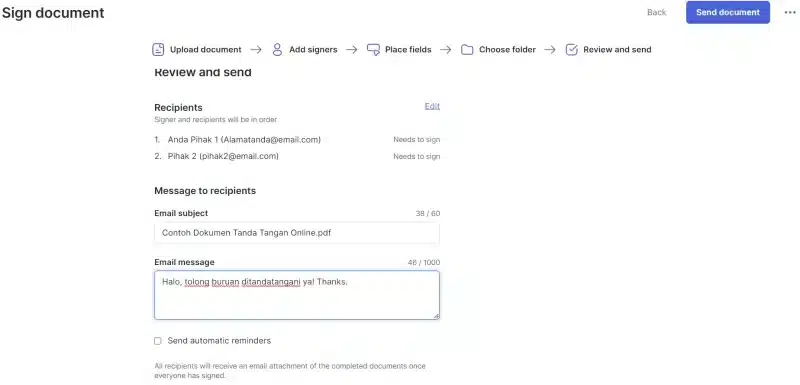
If everything is correct, click Send document in the top right corner. Eventually, when all parties have signed, they will receive a copy of the document in their email.
Electronic Signature Workflow
The following is the process flow of electronic signatures:
- First, the message sender will calculate the message’s Message Digest (MD). This MD is obtained by converting the message M with a one-way hash function.
- Next, encryption occurs on the MD using a private key cryptographic algorithm, such as the RSA algorithm. The encrypted result is called a digital signature (S).
- Then, the digital signature (S) is placed on the message M.
- After that, the signed message M with S is sent using a communication channel.
- When message M has reached the recipient, a verification process will occur to prove the message’s authenticity. Here is the verification process:
- The digital signature (S) is decrypted using the public key provided to the recipient. This process will eventually produce the MD (Message Digest).
- Then, the recipient converts M to MD with a one-way hash function. This hash is similar to the one used by the sender.
- If the result is MD = MD, then the received signature is valid and from the correct sender.
The Difference Between Electronic Signatures and Digital Signatures
Electronic signatures and digital signatures may seem similar, but significant differences between the two make electronic signatures more secure.
Here are the five key differences between e-Signature and d-Signature:
|
Electronic Signature |
Digital Signature |
|
| Form | Cryptographic mechanism | Digital data attached to a document |
| Creation Process | Uses asymmetric cryptography | The simple signature creation process |
| Identity Validation | Requires electronic certificate and liveness detection test | Cannot be accurately validated for the signatory’s identity |
| Legal Recognition | Legally recognized in numerous countries | Legally recognized but may not be deemed acceptable in certain situations |
| Security | Highly secure | Less secure than electronic signatures, more prone to forgery or fraudulent use |
Tips for Using Electronic Signatures
1. Keep your eKYC up to date
To ensure that you can continue using Mekari Sign’s electronic signature services, it is essential to keep your eKYC up to date.
Make sure to update your eKYC whenever there are any changes to your personal information, such as a new phone number or address.
2. Use a secure PIN
When creating your PIN, choose a strong and unique password that takes guesswork. This will help ensure your electronic signature is secure and not easily hacked.
3. Check your document
Make sure your document’s format and size are before you upload it. Check whether it is in a supported format, like PDF, JPG, JPEG, PNG, DOC, or DOCX. Additionally, ensure that the file size does not exceed 25 MB.
4. Verify the signatories’ email addresses
Before sending the document, check that all signatories’ email addresses are entered correctly. This will assist with guaranteeing the record is shipped off to the ideal individuals and endorsed by the planned gatherings.
What’s Next?
To sum up, electronic signatures are a game-changer for those who frequently sign documents. They provide a secure, user-friendly, and eco-friendly alternative to traditional signatures and are growing in popularity daily.
To start enjoying the benefits of electronic signature, try out Mekari Sign – the best electronic signature solution for modern businesses.







